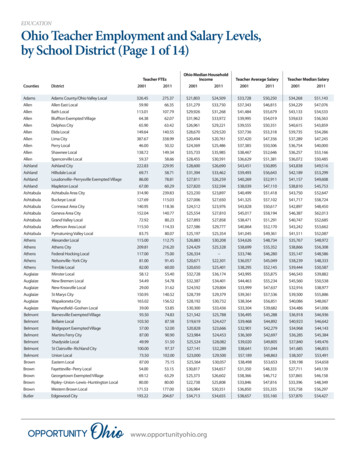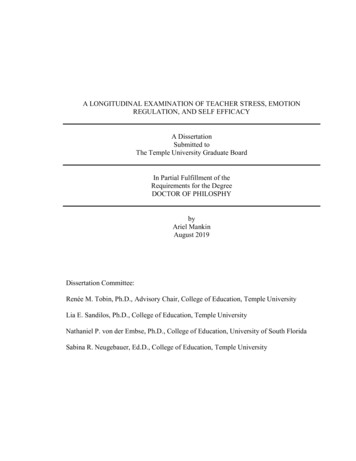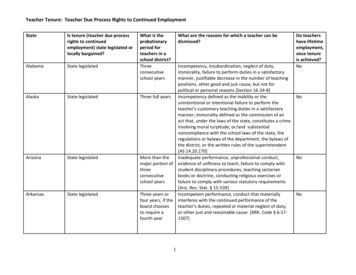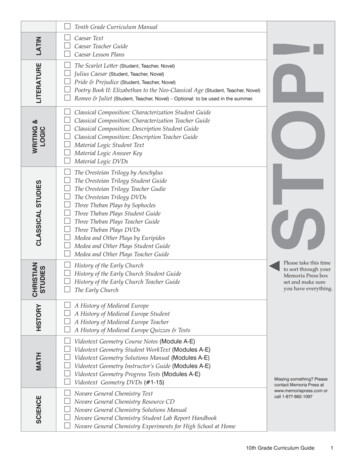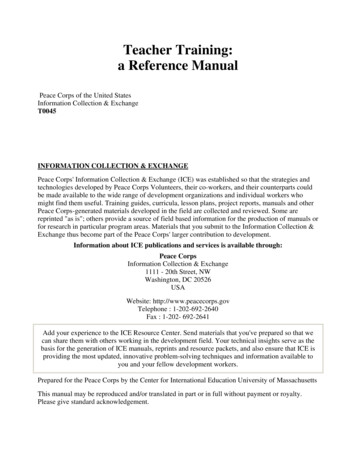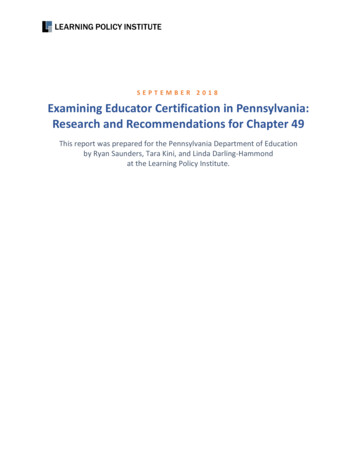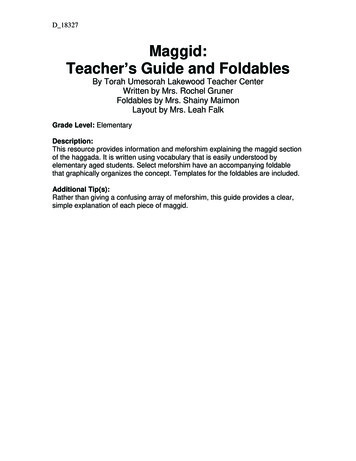
Transcription
D 18327Maggid:Teacher’s Guide and FoldablesBy Torah Umesorah Lakewood Teacher CenterWritten by Mrs. Rochel GrunerFoldables by Mrs. Shainy MaimonLayout by Mrs. Leah FalkGrade Level: ElementaryDescription:This resource provides information and meforshim explaining the maggid sectionof the haggada. It is written using vocabulary that is easily understood byelementary aged students. Select meforshim have an accompanying foldablethat graphically organizes the concept. Templates for the foldables are included.Additional Tip(s):Rather than giving a confusing array of meforshim, this guide provides a clear,simple explanation of each piece of maggid.
1 מגיד A Teacher’s Resource
Now that we have finished קדש through יחץ , we are ready to begin sayingthe הגדה .We will perform the great mitzvah of ספור יציאת מצרים .Introduction to MaggidThe question arises how come we do not recite a Brocha before beginning themitzvah of ספור יציאת מצרים , just as there are so many other Mitzvos upon whichwe recite a Brocha prior to doing the mitzvah.The מהר”ל answers that we are not required to say a Brocha on a mitzvah that isbased on feelings that we have in our hearts. (That is why we do not say a Brochaon the Mitzvah of ’ אהבת ה and ’ יראת ה .) Since tonight at the Seder it is a mitzvahfor all of us to feel as if we ourselves just left מצרים , we do not recite a Brocha onthis mitzvah, because it involves our feelings.FOLDABLE M001OUTSIDE1 מגיד A Teacher’s ResourceINSIDE
הא לחמא עניא We uncover the matzos and we all say “ הא לחמא עניא .” הא לחמא עניא talks about the Matzah that was eaten in מצרים . Why are we rejoicingthat we left מצרים if we are still in גלות now, and we are waiting for the גאולה tocome?This גלות that we are in now is different than גלות מצרים and the other גלויות . Those גלויות had a set time exacty when each גלות will end. This גלות does not have a settime to end. It is up to us to bring the גלות to an end.We can do this by doing Teshuvah and giving Tzedakah. “ציון במשפט תפדה ושביה בצדקה״ -Yerushalayim will be redeemed through Teshuvah and Tzedakah!That is why we say ” ”כל דכפין ייתי ויכול . Whoever wants can come and eat. Wewant to show that we will busy ourselves with giving צדקה and feeding the poorso that we can help the גאולה to come. לשנה הבאה בני חורין , we hope that through our actions of Teshuvah and Tzedakah,the גאולה will be here next year!We continue to say השתא הכא - now we are here in גלות , but with the zechus ofthe mitzvah of tzedakah, we can merit to have the גאולה come by next year, andthus we will be ” “בני חורין .Wrapup: הא לחמא עניא כל דכפין ייתי ויכול לשנה הבאה בני חורין 2 מגיד A Teacher’s ResourceThis matzah represents the Galus of Mitzrayim.Represents us giving tzedakah so we can merit the גאולה .Represents our hopess of being next year in ירושלים .
FOLDABLE M002OUTSIDEINSIDEWe now cover the matzos and fill the ה - כוס שני with wine.Q:Why do we pour the second cup of wine now if we will not be holding it ordrinking it until much later?A:The answer is; simply just to make the children curious at the Seder, and toencourage them to ask questions.( רש”י , )פסחים FOLDABLE M003 מה נשתנה We are about to begin asking the מה נשתנה . The youngest child inthe family is usually the first to ask the four questions of מה נשתנה .3 מגיד A Teacher’s Resource
Q:Why do we not ask in the מה נשתנה the reason for drinking four cups of wineat the Seder?A:We do not ask a question about the ארבע כוסות because the Mitzvah of ארבע כוסות is not Min HaTorah, whereas all of the other questions in מה נשתנה reflect Mitzvos that are discussed in the Torah. ( )מהר”ל Eating Matzoh is Min Hatorah.Eating Marror is Min Hatorah.Dipping is done with Marror, which is Min HaTorah.Leaning is done with Matzoh, which is Min HaTorah.The first two of the four questions of the מה נשתנה tell the story of the sufferingof ל - בני ישרא in גלות מצרים . The next two questions tell of the great נס of ל - בני ישרא being freed from the slavery in Mitzrayim.The Gemara in פסחים instructs us to begin מגיד by talking of the disgrace andhardships of ל - בני ישרא in Mitzrayim, and only after that to then lead intotalking of the glorious wonders of ב”י leaving מצרים and being led to freedom.The reason for this is if we would not begin the Seder with a discussion of theterrible disgrace and hardship of the slavery that ב”י endured in Mitzrayim,we would not come to truly appreciate the greatness of all the Nissim relatedto leaving Mitzrayim. We must always feel הכרת הטוב for the Chesed andwonders that Hashem has done for us in Yetzias Mitzrayim! ) (מלבי״ם אכילת מרור , אכילת מצה Allude to the long years of suffering in Mitzrayim. מסבין , מטבילין Allude to the pleasantness of the freedom that ב”י experienced when Hashem took them outof Mitzrayim.FOLDABLE M0044OUTSIDE מגיד A Teacher’s ResourceINSIDE
FOLDABLE M005OUTSIDEINSIDE עבדים היינו We partially uncover the Matzos and make sure that the קערה is inthe center place of the table. We then recite עבדים היינו , which is theanswer to the !מה נשתנה Explanation of עבדים היינו We were slaves to פרעה in Mitzrayim, which was a fortified and locked country.This made it impossible for slaves to escape! Yet Hashem took us out with amighty hand and outstretched arm. If Hashem would not have taken us outof Mitzrayim then, we would still be enslaved to those in power in Mitzrayim.Therefore, even if we are all wise and experienced , and we all know the Torah,we still ALL have the חיוב of telling the story of יציאת מצרים . All those who discuss ספור יציאת מצרים at length are worthy of praise! That is because talking about ספור יציאת מצרים brings more honor to Hashem.The ל - אברבנא explains that this paragraph of עבדים היינו is the one clear answer toALL four questions of the מה נשתנה . How?We do things at the Seder that symbolize the עבדות במצרים . This is the answerto the first two questions.We do other things at the Seder that symbolize the חרות that we experiencedwhen Hashem took us out of Mitzrayim. This is the answer to the last twoquestions.5 מגיד A Teacher’s Resource
FOLDABLE M006OUTSIDEINSIDE מעשה ברבי אליעזר Everyone is obligated to discuss ספור יציאת מצרים at length. This includes eventhose people who are descendants of the Kohanim, Leviim, or Geirim. TheKohanim, Leviim, and Geirim were not slaves in Mitzrayim. Even so, those ofus who come from Kohanim, Leviim, or Geirim have to be equally involved intelling the story of יציאת מצרים .This is apparent from the story that we are about to read in the Hagaddah. רבי אליעזר is a Levi רבי יהושע is a Levi ה - רבי אלעזר בן עזרי is a Kohein רבי עקיבא was a descendant of Geirim רבי טרפון was a KoheinThey all gathered together at a Seder in the city of בני ברק where רבי עקיבא lived.( רבי עקיבא was )רב העיר . They were discussing ספור יציאת מצרים at such great lengthsthroughout the night until, in the morning, their students came to notify themthat it was indeed the morning already. It was time to daven !קריאת שמע של שחרית 6 מגיד A Teacher’s Resource
FOLDABLE M007OUTSIDEINSIDE. אמר רבי אלעזר בן Rabbi Elazar is referring to himself when he says, “I am like a man of seventyyears old.”Rabbi Elazar was really only 18 years old at the time that he wasappointed as a נשיא . Hashem performed a נס , and רבי אלעזר grew a long beardthat made him appear to be at least seventy years old. Hashem made thishappen in order to make sure that people will respect רבי אלעזר as a נשיא despitehis young age.This is the reason why the בעל הגדה writes ” “כבן שבעים שנה , like seventy years old,because he really was 18 years old!***Rabbi Elazar tried to prove to the other חכמים that the mentioning of יציאת מצרים is not only an obligation during the day, but it is also an obligation duringthe night. He was not successful in proving this until בן זומא explained it in thefollowing way:The Pasuk states: ” ”למען תזכר את יום צאתך מארץ מצרים כל ימי חייך : From here we learnthat there is a mitzvah to mention yetzias mitzrayim in קריאת שמע every day, allthe days of your life. בן זומא explains ימי חייך - Days of your life: teaches us that we must mention יציאת מצרים during the daytime.7 מגיד A Teacher’s Resource
) כל (ימי חייך : This extra word ” ( “כל all days of your life) is written to include ALLtimes of day, which would include the night.The חכמים explain this differently: We are required to mention יציאת מצרים throughout all these days of גלות . The extra word ” “כל teaches us that we willstill be mentioning יציאת מצרים even after the coming of משיח . גלות גם כן בימות המשיח ימי חייך כל ימי חייך FOLDABLE M008OUTSIDEINSIDE ברוך המקום ” ”המקום refers to Hashem, who is called “The Place,” because He is in everyplace in the world. ל - ברוך המקום ברוך הוא ברוך שנתן תורה לעמו ישרא : We give a ברכה and שבח to Hashemfor giving us the Torah.We then continue saying ”. “כנגד ארבעה בנים דברה תורה , the Torah speaks of fourdifferent types of sons: The חכם - wise son The רשע - wicked son The תם - simple son The אינו יודע לשאל - son who does not know how to askQ: What is the connection between ברוך המקום , where we praise Hashem andbless Him for giving us the Torah, and the rest of the paragraph, , כנגד ארבעה בנים ,8 מגיד A Teacher’s Resource
which explains the four different types of sons among families in Klal Yisroel?A:We begin by thanking and blessing Hashem that He gave us the Torah.The Torah is the tool that teaches us how to take care of all of our children,no matter who they are! The Torah is our guide to help us reach all types ofchildren, even the !רשע The רשע is not forsaken. He is still within the boundaries of Hashem’s presence,and there is always hope that he will do teshuvah and return to the ways ofHashem and the Torah.The Torah talks to all four children. Through the learning of Torah, all fourchildren can develop according to their level and grow in the ways of theTorah! Every father has an obligation to teach his children the ספור יציאת מצרים ina way that they will understand.Hashem wants us to tell the story of יציאת מצרים to each type of child accordingto his level. That is why the הגדה talks about the four different types of sons thatparents can have. חכם מה הוא אומר? מה העדות והחקים והמשפטים The הגדה begins with the חכם : The חכם , the wise son, wants to know abouteverything related to the מצוות of פסח .He wants to know about the “ “עדות , which means the things that we do atthe Seder that have a “ ”טעם , a reason, that testify to the גאולה from מצרים : Thismeans that the חכם wants to know about the following mitzvos. Eating the Matzah and the Marror Eating the Korban PesachThe חכם also wants to know about the “ “חקים and the “ ”משפטים , the varioushalachos and details of the Dinim that are related to the קרבן פסח that do nothave such a clear explanation to us. (Such as not being allowed to break abone of the קרבן פסח , and who may not be permitted to eat the )קרבן פסח .Answer to the חכם : Because the חכם wants to know so much about the Mitzvosof Pesach, we tell him the ספור יציאת מצרים , and we also teach him all of theHalachos related to קרבן פסח .We end off by teaching the חכם the Halacha “. “ אין מפטירין אחר הפסח . It wasforbidden to eat anything after eating the קרבן פסח . The reason for this is so that9 מגיד A Teacher’s Resource
the taste of the קרבן פסח should linger in our mouths. Therefore, after we eat the אפיקומן , which is instead of the קרבן פסח , we are not permitted to eat anythingelse so that the taste of the Mitzvah should linger in our mouths, and in ourhearts!This concept of causing the taste of the קרבן פסח to last in our mouths teachesus that a father should relate the story of Pesach to his children with suchpassion, that the “taste” of גאולת מצרים will last forever in the minds and heartsof his children!? מה העבודה הזאת לכם : רשע מה הוא אומר The הגדה then speaks of the next son, the רשע . The רשע , the wicked son, says“What is this work of yours?”The רשע is referring to the קרבן פסח when he talks about ” “עבודה . He does nottake part in this Mitzvah, or any other Mitzvos.Hashem’s goal when taking ל - בני ישרא out of מצרים was not only to free themfrom the torturous slavery. The goal was more to enable ב”י to serve Hashemand observe His Torah and Mitzvos.The רשע does not want to serve Hashem. That is why he says ” “לכם , for you,because he does not include himself in ל - עם ישרא . In that case, he would notbe part of the גאולה because he has no interest in being an ’ עבד ה .(Reb YecheskelLevenstein)The רשע is also saying something else to us:“Why are you busy with celebrating Pesach and all the mitzvos related to it? ל - בני י שרא were freed from גלות מצרים , but we are now in Galus again, so whycelebrate?” The רשע does not realize that we are celebrating that we werefreed from the טומאה of מצרים , and that is why we continue to celebrate יציאת מצרים in this גלות .Answer to the Rasha: ה שם - ואלו הי . בעבור זה עשה ה’ לי : “ואף אתה הקהה את שניו ואמר לו ” ה נגאל - לא הי The הגדה tells us to “blunt his teeth,” which means to speak sharply to him.The father should tell him: “Hashem performed Nissim for ME when I left מצרים ,10 מגיד A Teacher’s Resource
in order that I should be able to keep His Mitzvos. But that does not includeYOU, the רשע , because you would not have been part of the גאולה . What doesthis mean?Reb Moshe Feinstein זצ”ל explains the answer.“ “אין לך בן חורין אלא מי שעוסק בתורה . A free man is one who keeps the Torah. Sincethe רשע does not wish to keep the Torah, he is not free! He is not a part of the גאולה .Interesting Thought:”. רשע מה הוא אומר ,. “חכם מה הוא אומר We can also explain these words in a way that teaches us an important lesson.A חכם shows others who he truly is by what he says and how he says it.A רשע also shows others what type of person he is by what he says and how hesays it! That is why we always have to be so careful with our words and how wespeak ? מה זאת : תם מה הוא אומר The תם , the simple son, asks “What is this celebration all about?The תם is very simple minded. He does not think into anything too deeply. Heis not like the חכם who can ask detailed questions. He just simply asks “Whatis this?” when he sees all of us celebrating the Seder and doing so manydifferent things. (He is seeing things that we do not ordinarily do on a regularnight or during a different chag.)Answer to the תם m ” ”בחזק יד הוציאנו ה’ ממצרים מבית עבדים We are doing all of these special mitzvos tonight at the Seder in order toremember all the miracles that Hashem did for us in Mitzrayim, and all themiracles that He did for us when we left Mitzrayim. לו את פתח , ושאינו יודע לשאול As for the אינו יודע לשאל , the son who does not know how to ask, “You” mustopen up the conversation for him, as it says in the Torah” “ והגדת לבנך ביום ההוא .You should say to him, “Hashem performed many miracles for me when I left11 מגיד A Teacher’s Resource
Mitzrayim, in order that I should be able to keep His Mitzvos, such as theMitzvos that we are doing tonight at the Seder: מרור , מצה , קרבן פסח .It is not that this son knows absolutely nothing. It is just that he is not goodat thinking deeply into things and asking the proper questions.Q:Why does the בעל הגדה use the word ” “את in לשון נקבה , instead of ” “אתה in לשון זכר , as he does throughout the ?הגדה The הגדה is speaking to the father,which means it should say ” “אתה .A: There are many different answers to this question. Harav Leib Gurwitz zt”lof Gateshead explains it so nicely and clearly.There is a difference between how a father teaches his son and how a motherteaches her son. The father will teach his son with his שכל , with his head andhis knowledge. The mother, however, will teach her son with her הרגש , withher emotions and her strong feelings for her child.A father should teach this son as a mother would. ( )את This means that afather should teach him with warmth, patience, and feeling. Then you willbe able to reach his heart and his mind, thus helping him to understand themitzvos!FOLDABLE M009OUTSIDE12 מגיד A Teacher’s ResourceINSIDE
יכול מראש חדש This paragraph of the הגדה talks about when exactly is the actual mitzvah of ספור . יציאת מצרים The following are the possibilities: Is it beginning from ?ראש חדש ניסן Is it during the day of the bringing of the ?קרבן פסח Is it only on the night of the Seder, when the קרבן פסח was eaten? It is possible that a person can think that the mitzvah of ספור יציאת מצרים begins already on ראש חדש ניסן . Why would a person think that way?A person can think that way because Hashem actually commanded to ב”י themitzvah of קרבן פסח on ראש חדש ניסן . Moshe was already explaining to ב”י all ofthe Halachos pertaining to the קרבן פסח beginning from ראש חדש ניסן . Additionally,HaRav Moshe Feinstein explains that the entire גאולה from מצרים began on ראש חדש ניסן .However, the time for the actual carrying out of the mitzvah of ספור יציאת מצרים is on the night of Pesach! The Torah tells us ” “והגדת לבנך ביום ההוא , on that day,which is the day of the קרבן פסח . One can think that it is required to begin theMitzvah during the day. However, the Mitzvah starts at night, when the Matzohand Marror are in front of you at the Seder table.Rav Chaim Shmulevitz zt”l explains why telling the story of Mitzrayim specificallyat the Seder is beneficial. The children will better understand everything thattheir fathers are teaching them about מצרים when they can actually visualizethe details of the Seder in front of them; the Matzoh, Marror, the קערה , etc.They will internalize it and will take an active part in the learning.To sum up, the main celebration of יציאת מצרים is not on the day that יציאת מצרים began, but on the day that we left and were out for good!Interesting Gematria:” בשעה שיש מצה ומרור מנחים לפניך . “בעבור זה For this, which refers to the matzoh andMarror in front of us on the Seder table זה is equal in Gematria to 12. [7 5 ה , ]ז , which can be paralleled to the 12different mitzvos that we do on the night of the Seder:13. כורך , מרור , מצה , המוציא , נטילת ידים 2 , כרפס , חרוסת , כוסות 4 מגיד A Teacher’s Resource
FOLDABLE M0010OUTSIDEINSIDEINSIDE14 מגיד A Teacher’s Resource
. מתחילה עובדי This paragraph begins telling us the history of ל - בני ישרא tracing back to Terachand leading up to מצרים . מתחלה Originally, our ancestors before אברהם אבינו worshipped idols.These words refer to תרח , who lived ” ”מעבר לנהר , on the other side of נהר פרת .The הגדה begins speaking about תרח , the father of אברהם אבינו . Terach was an עובד עבודה זרה . However, his son אברהם came to recognize Hashem on his own asthe creator and the master of the world. אברהם אבינו taught his children to followin the ways of Hashem. חז”ל tell us that the הגדה begins with the גנות of our nation, and it ends with thepraise of our nation.“ ”מתחיל בגנות מסיים בשבח The גנות that we speak about in the Haggadah is תרח , as well as the wholesegment of עבדים היינו The שבח of course, is the entire wondrous story of !יציאת מצרים There is a very great and important lesson to learn from the fact that we begintelling ספור יציאת מצרים with the bad ( (גנות and end with the praise) (שבח אברהם אבינו did so much good in his lifetime by recognizing Hashem and bringingpeople closer to Him. This was an amazing feat. It is what caused ל - עם ישרא toinherit ל - ארץ ישרא . It was not that the land was an automatic inheritance. ירושת ל - ארץ ישרא was merited by the actions of אברהם אבינו .This should serve as a נחמה to us in our own גלות . Our תשובה ומעשים טובים canaccomplish the deliverance of our גאולה as well!We should not get discouraged that our עברות have made us hopeless. Look atour אבות who stemmed from עובדי עבודה זרה and were able to become closer toHashem, as it says in the Haggadah,“ “ועכשו קרבנו המקום .15 מגיד A Teacher’s Resource
. ואקח את אביכם This paragraph tells us the sequence of events that happened after תרח .Hashem took אברהם from חרן and led him throughout ארץ כנען .He gave אברהם a son, who was born on !פסח This was יצחק .t ( (מדרש וירא יצחק gave birth to יעקב and עשו . יעקב and his sons went down to מצרים and were brought back to ל - ארץ ישרא aspromised by Hashem. עשו was given הר שעיר as a place to live, and he remained there. ברוך שומר הבטחתו In this paragraph, we are thanking and bentsching Hashem for keeping Hispromise and taking us out of גלות מצרים . We thank Hashem for punishing ouroppressors, just as He had promised אברהם אבינו in ברית בין הבתרים .The שבלי הלקט explains the words ” ל - “ברוך שומר הבטחתו לישרא in a way that gives כלל ל - ישרא constant חיזוק and encouragement. Just as Hashem watched his promiseto אברהם אבינו and took ב”י out of מצרים and brought the גאולה , so too, Hashemis watching His promise on bringing the future גאולה for us, and is calculatingwhen the end of the Galus will be.The Haggadah tells us now to cover the Matzos and to lift up the כוס and saythe next paragraph of the Haggadah. The reason that we cover the Matzos isthat we do not want to embarrass the Matzos when we lift up the Kos, just aswe cover the Challos on Shabbos when we make Kiddush.16 מגיד A Teacher’s Resource
The reason why we lift up the Kos is to show thanks to Hashem for saving usthroughout the generations. והיא שעמדה לאבותינו והיא And THIS. THIS refers to Hashem’s promise to אברהם אבינו in ברית בין הבתרים .This promise of ” “ואחרי כן יצאו is what stood by and protected our Fathers andourselves throughout all the generations.We need this promise of Hashem’s protection throughout all the generationsbecause it is not only פרעה that rose up against us and tried to destroy us!But, in every generation there are those (enemies) who try to destroy us, andHashem saves us from their hands. That is why we say in the הגדה the words“ “שלא אחד בלבד עמד עלינו לכלותינו .The Medrash tells us that Hashem actually showed אברהם אבינו in ברית בין הבתרים all of the nations that in the future would cause hardship to ל - כלל ישרא and bringthem into גלות . Those nations are: אדום , יון , מדי , בבל The Medrash explains that Hashem promised in ברית בין הבתרים to not only take ב”י out of גלות מצרים , but to also take ל - כלל ישרא out of all of these other גלויות that ב”י will endure. We always rely on Hashem’s salvation from our enemies. והיא - And THIS: There are many ways that our מפרשים explain as to what theword “ ”והיא is referring to. (This is in addition to ” ”והיא referring to ברית בין הבתרים .)Below are two of the many fascinating explanations of what the word ” “והיא isreferring to.Q: What was ”THIS” that stood strong throughout the generations?A: 1. The שכינה of Hashem. It is always with us, even when we are in !גלות The שכינה protects us from being completely destroyed by our enemies. This is thereason why we are supposed to lift up the כוס when reciting והיא שעמדה . We areshowing respect to the שכינה of Hashem ) (קב הישר בשם האר”י 2. The ראשי תיבות of the word ” “והיא represent what has protected ל - עם ישרא fromdestruction throughout the generations! א ה’ אחד , י עשרת הדברות , ה חמשה חומשי תורה , ו ששה סדרי משנה It is the זכות of למוד התורה וקיום המצוות that causes us to withstand the tormenting17of our enemies who are always trying to destroy us! ( )אברבנאל מגיד A Teacher’s Resource
We uncover the Matzos and put down the כוס and continue saying the הגדה .FOLDABLE M0011OUTSIDEINSIDE. צא ולמד This paragraph is teaching us a very important יסוד .Although we may not always feel the wonders that Hashem is doing for us ona constant basis, even so, He is always performing נסים for us. צא Leave the story of יציאת מצרים aside ולמד And learn how Hashem saves us from those who try to destroyus in every generation.A perfect example of this would be how Hashem saved us from what לבן wantedto do to Yaakov Avinu. צא ולמד מה בקש לבן הארמי לעשות ליעקב אבינו We can very clearly learn this from לבן . How?On the surface, לבן did not look like he wanted to cause harm to יעקב . He madehimself look like a friend to יעקב . After all, his daughters, Rochel & Leah, weremarried to !יעקב However, in reality, לבן wanted to kill יעקב . Hashem knew thetruth about לבן , and He saved Yaakov and his family from ’לבן s evil hands.We have a lesson to learn from this. We have to be aware that in גלות , the othernations are a threat to us. They may appear to be our friends, but in reality,18 מגיד A Teacher’s Resource
they want to destroy us. ” “הלכה ידועה שעשו שונא ליעקב לבן was even worse than פרעה . How? פרעה issued a decree only on the ” “זכרים , the boys. לבן , however, wanted to ruin ’יעקב s entire family, as it says ״ . ״ארמי אבד אבי Lavan wanted to destroy יעקב andhis family after they ran away from him.” “ויהי שם לגוי גדול עצום ורב . Eventually, יעקב and his family went down to live in מצרים in small numbers (70 people), and they became a great nation there despitethe fact that לבן had wished to annihilate them.” “וירד מצרימה אנוס על פי הדבור Yaakov was forced to go down to מצרים because ofthe דבור .What דבור , spoken word, is the בעל הגדה referring to here? דבור can be explained in two different ways:1. יעקב went down to מצרים because of the words of ברית בין הבתרים that Hashemhad promised to Avraham.2. יעקב went down to מצרים because of the words of Yosef to his father abouthis brothers. These words of לשון הרע that יוסף said about his brothers causedthem to become angry at him and sell him as an עבד . Yosef ended up beingsold as an עבד to מצרים .Eventually, יעקב went down to מצרים to live in גשן so thathe could be reunited with יוסף . “ויגר שם” מלמד שיעקב אבינו לא ירד למצרים ויגר שם means that he stayed over there. These words teach us that יעקב did notgo to מצרים to permanently settle there, but only to stay there temporarily untilthe רעב in ארץ כנען was over.We see in ד , מ”ז : פרשת ויחי that the שבטים told פרעה that they need to come andtemporarily live in גשן . The רעב in כנען is so bad, that there is even no grasslandfor the sheep to graze.Interesting Thought:There is a הלכה that a person is not allowed to taste a thing until he has fed hisanimals. Therefore, the בני יעקב felt compelled to go and live in מצרים for thesake of their animals having what to eat!19 מגיד A Teacher’s Resource
. בשבעים נפש : ” כמה שנאמר , “במתי מעט The בעל הגדה tells us that יעקב and his family were “very few” in numbers whenthey went down to live in מצרים . They were ” “שבעים נפש , seventy people. Yet,Hashem made them become so many, as many as the ” “כוכבי השמים , the stars ofthe sky.Q: Why does the הגדה use the word ” “נפש , which is לשון יחיד , instead of using theword ” “נפשות , which is ?לשון רבים Seventy people should really be described bythe word נפשות .A: 1. The הדגה uses the word נפש , which is לשון יחיד , to show that there was שלום between themselves. They were united as one! There was no לשון הרע or מחלוקת amongst each other.2.The word ” “נפש is equal to the gematria of 430. This symbolizes the amountof time from ברית בין הבתרים until the end of גלות מצרים .430 300 ש ,80 פ ,50 נ . ל מצינים שם - מלמד שהיו ישרא ,” ויהי שם לגוי “And he became a nation there.” This teaches us that ל - בני ישרא stood out fromamong the rest of the people in מצרים as a nation of their own. ל - בני ישרא acted differently than the people in מצרים . In what way did they standout? ל - בני ישרא did not change three things when they lived in מצרים : שמם They kept their Jewish names. לשונם They spoke their own language, not Egyptian. מלבושם They kept to their own style of clothing and did not start to dress likethe מצריים .The Medrash states that in the זכות of ל - בני ישרא preserving these 3 things andcausing themselves to be noticeably Jewish, they were redeemed from מצרים :”. שהיו מצוינים במצוות , נגאלו אבותינו ממצרים . , לבושם , לשונם , **”בזכות שלא שינו שמם . ל פרו וישרצו - ובני ישרא : כמה שנאמר , גדול עצום These next few lines in the הגדה describe how ב”י became so strong and mightyin מצרים . Despite the impossibly hard physical work that they were forced to doin מצרים , Bnei Yisroel continued to multiply. The women were giving birth to six20 מגיד A Teacher’s Resource
babies at once! They ultimately filled up the entire land of מצרים and becamevery very mighty, as it says, “! “ויעצמו במאד מאד . ויתנו עלינו עבדה קשה , וירעו אתנו המצרים ויענונו פרעה was very upset that ב”י were becoming so mighty in his country. He wouldhave truly loved to completely destroy their entire nation! However, it wouldnot have looked too good for פרעה to do something like that. After all, HE wasthe one who invited them into מצרים years before, as the Pasuk in פרשת ויחי states”. “קחו את אביכם ובתיכם ובואו אלי . Thus, it would have been an embarrassment forthe entire nation of מצרים to invite in a nation and then turn around and destroythem.That is why פרעה used a different approach to try to get rid of ב”י . He triedto implement ways to gradually decrease the Jewish nation. These are theactions that פרעה planned and carried out: פרעה made a גזרה to kill the baby boys.)”. ) ”הבה נתחכמה לו פרעה issued a tax to all the Jews. פרעה made ב”י work as his slaves and do עבודת פרך without pay. פרעה appointed supervisers to stand over the slaves while th
Teacher's Guide and Foldables By Torah Umesorah Lakewood Teacher Center Written by Mrs. Rochel Gruner Foldables by Mrs. Shainy Maimon Layout by Mrs. Leah Falk Grade Level: Elementary Description: This resource provides information and meforshim explaining the maggid section of the haggada.

